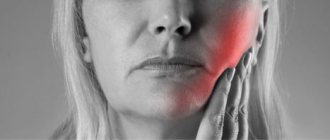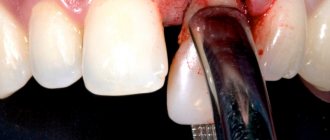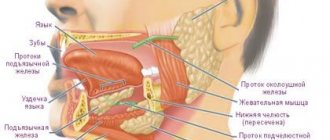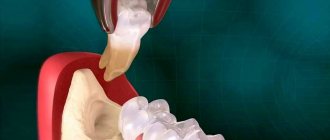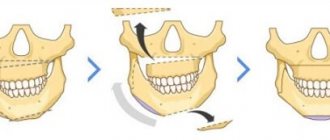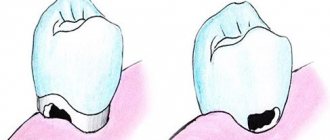Many people are familiar with the phenomenon of gumboil - when the cheek next to a sore tooth swells literally before our eyes and painkillers do not relieve acute pain. This is the periosteum of the tooth becoming inflamed, or, as doctors say, odontogenic periostitis of the jaws has developed. This disease in itself is a complication of dental problems (periodontitis, periodontitis), but in the absence of proper treatment, such inflammation can also cause the development of even more serious complications.
Why can the periosteum of a tooth become inflamed?
The most common is odontogenic periostitis of the jaws, that is, an inflammatory process provoked by diseases of the teeth or periodontal tissues. Deep caries, pulpitis, periodontitis (inflammatory process at the apex of the tooth root), periodontitis - all these diseases, if not treated in time, lead to the appearance of gumboil. Also, one of the reasons for the development of the inflammatory process may be alveolitis - inflammation of the tooth socket, which in some cases occurs after tooth extraction. Inflammation of the periosteum after tooth extraction usually develops in those patients who do not rush to see a dentist when the first signs of complications appear in the postoperative period.
Much less common is toxic periostitis, caused by infection through the blood or lymph (usually due to some general infectious disease). The disease can also be caused by injuries to the jaw bone or surrounding soft tissue.
Preventive measures.
As you can already understand, periostitis is a serious and dangerous dental disease. To prevent its occurrence, you must adhere to several rules:
- Maintain good oral hygiene.
- Have a comprehensive examination with your dentist at least once a year, and don’t forget about x-rays. It will help diagnose inflammation of the periosteum in the early stages.
- Avoid fights, and protect your face from injuries and blows.
Inflammation of the periosteum of the tooth: symptoms
Depending on the form and localization of the process, symptoms may be as follows:
- General symptoms: severe pain in the area of inflammation, swelling, noticeable swelling, discoloration of the gums, mobility of the dental unit, which served as a source of spread of the pathological process. Depending on the location of the source of infection, facial swelling will look different: when inflammation develops near the front teeth, the upper lip or middle third of the face swells; when inflammation occurs near the chewing teeth, the cheek, sometimes the lower eyelid, and parotid area swell. You can evaluate what different types of edema look like during inflammation of the periosteum of the tooth using a photo.
- Acute serous periostitis of the lower or upper jaw is accompanied by severe redness of the mucous membranes, rapid development of edema, and increased body temperature. The general symptoms of this form of inflammation are especially pronounced.
- In the acute purulent form of the disease, severe sharp pain is characteristic, and the pain subsides under the influence of cold and becomes stronger when exposed to heat. Sleep and appetite are disturbed, the temperature rises noticeably, and the patient’s general condition worsens. Pain in most cases radiates along the branches of the corresponding nerves. For example, acute purulent periostitis of the lower jaw can make itself felt by pain in the neck, chin, ear and temporomandibular joint. Purulent periostitis of the upper jaw most often provokes pain in the orbital area, temporal bone, and ear.
- The chronic form of the disease is quite rare, and chronic periostitis of the lower jaw usually develops. The symptoms are mild, the swelling is almost unnoticeable and can gradually develop over a very long time. Pain and discomfort appear from time to time (periods of exacerbation).
At the initial stage of the inflammatory process, it usually has a serous form, later, without treatment, it becomes purulent. With a large accumulation of pus, the formed abscess can burst with the flow of purulent contents into the oral cavity. At the same time, the swelling decreases and the pain subsides. In this case, some patients calm down, believing that the problem has been solved, and are in no hurry to see a dentist. In fact, this is only temporary relief, since the pathological process can resume at any minute.
Periostitis in children
In children, the inflammatory process usually develops as a result of untreated caries of baby teeth, infectious diseases or injuries. Due to the peculiarities of the physiology and anatomy of the child’s body, as well as due to the immaturity of the child’s immune system, the pathology develops quickly and rapidly, and the infection quickly spreads through the bloodstream and lymph flow, so multiple lesions can form.
Periostitis of the upper jaw in a child requires special attention, which, when localized in the palate, may not change facial features - swelling forms inside the oral cavity and can only be noticed by the characteristic convex swelling on the palate. The abscess gradually grows, capturing the mucous areas of the pharynx and tongue, which causes pain when swallowing and chewing. If a child develops symptoms such as fever, loss of appetite, or painful swallowing, it is imperative to check whether such a condition is caused by developing gumboil.
Classification
Dentists classify pathology into the following types:
- Simple. It is the result of bruises and injuries. The lesion is found in close proximity to mechanical action. A person complains of aching pain and swelling.
- Fibrous. A consequence of prolonged irritation of the periosteum, for example, as a result of necrosis. During palpation, a painful thickening of the bone is detected. If the necessary measures are not taken in time, the tumor can greatly increase in size and become malignant.
- Purulent. The result of an infection that penetrated from the outside after damage to the integrity of the mucosa. This form is often found with abscess, osteomyelitis, and phlegmon. Its causative agents are streptococci and staphylococci. Serous exudate is actively released from the abscess. An abscess occurs. Further, several options for the development of pathology are possible. The first is that pus destroys a separate area of the bone structure and breaks into the soft tissue. The second is that pus contributes to the exfoliation of a separate section of the periosteum. Then the bone stops receiving the necessary nutrition and dies. This type of inflammation always manifests itself clearly. The patient's body temperature rises. The cheek swells and an abscess forms in the mouth.
- Serous. May form after injury. A large amount of serous mucus is discharged. It accumulates. As a result, the periosteum may peel off and die.
- Ossifying. Bone tissue gradually grows. The problem occurs due to prolonged irritation of bone structures. For example, chronic osteomyelitis leads to it.
- Tuberculosis. This form is characterized by the formation of fistulas, inside which pus accumulates.
- Syphilitic. Found in patients with syphilis. The bones of the jaw and skull are affected. Pain is the main symptom. It intensifies at night. If fistulas form and break through, your health temporarily improves.
To understand how to treat pathology, it is important to determine what caused the abnormal process. That is why, before starting therapy, the dentist collects anamnesis and conducts diagnostics.
Possible complications and diagnosis
If the disease is not treated properly, very serious complications soon develop: osteomyelitis (purulent inflammation of bone tissue, provoking its necrosis), phlegmon (a diffuse purulent process that affects nearby tissues and requires immediate surgical intervention), sepsis (a general infection of the body, often ending in the death of the patient ). Each of these conditions requires emergency medical care and long, painstaking treatment. Therefore, it is better not to let the situation lead to complications and contact a dentist at the first signs of an inflammatory process.
To establish an accurate diagnosis, the doctor will need to conduct a differential diagnosis using instrumental diagnostic methods (radiography, CT). This disease is similar in symptoms to acute periodontitis, acute inflammation of the salivary glands, lymphadenitis, and osteomyelitis. Therefore, in order to prescribe adequate treatment, it will be necessary to exclude these conditions and accurately determine the cause of the patient’s poor health.
Inflammation of the periosteum of the tooth: treatment
Periostitis of the lower and upper jaw requires almost the same treatment, despite some differences in symptoms and localization of lesions. Moreover, complex therapy will be required, which will quickly eliminate the infectious-inflammatory focus and prevent relapses:
- Surgery. Opening the purulent sac with removal of the contents and thorough cleaning of residual pus is a mandatory procedure in this case. The intervention is performed under local anesthesia. At the initial stage of the disease (with its serous form), it is possible to do without surgical intervention. In this case, the doctor carries out endodontic treatment (depulpation, cleaning and treatment of root canals, antibacterial therapy).
- Drug therapy. Prescribing antibacterial and anti-inflammatory drugs to eliminate inflammatory phenomena (swelling, hyperemia, fever, pain) and infection.
- Physiotherapeutic procedures. Iontophoresis, ultrasound or laser therapy, electrophoresis, paraffin therapy - all these procedures are usually aimed at resolving compactions formed as a result of the pathological process. As a rule, physiotherapy is used for chronic forms of the disease, but in some cases it can be used in the complex treatment of acute purulent forms.
Antibiotics for inflammation of the periosteum of the tooth are prescribed during the treatment process; they are necessary to eliminate the bacterial infection, which is one of the causes of the development of the purulent-inflammatory process. The doctor selects medications based on the severity of the disease, the general condition of the patient’s body and the possible presence of concomitant diseases. Along with antibiotics for periostitis of the jaw, antihistamines (antiallergic) are also prescribed as treatment, which can reduce the drug load on the immune system, as well as calcium supplements.
The success of treatment largely depends on the patient’s timely visit to the doctor and the effectiveness of the therapy itself. And if in the first case everything depends on the patient - his conscious attitude towards his own health, then in the second the success of treatment is completely determined by the qualifications and experience of the dentist to whom the patient turned. A competent specialist with extensive clinical experience will quickly and successfully cope with even such a complex disease, while an amateur can further aggravate the problem. Therefore, choosing a good specialist is important here - these are the specialists who work at the 32 Dent clinic. Our doctors have extensive experience in successfully treating any purulent-inflammatory diseases of the oral cavity, including periostitis.
Diagnostic measures
The doctor conducts an examination. It is not difficult to understand that a bone is damaged. This is indicated by external signs:
- redness of the gums;
- pain when pressing;
- the presence of a cushion containing pus;
- mobility of the incisor, canine, molar (noted if the disease is advanced).
To determine the stage of the disease and the depth of damage to bone formations, the doctor performs an X-ray or radiovisiography of the jaw.
How to treat inflammation of the periosteum of a tooth before visiting a doctor?
Self-medication for any purulent processes is very dangerous, so it is recommended to consult a dentist at the first symptoms of the disease. However, before visiting a doctor, the patient can alleviate his condition somewhat by applying cold to the cheek on the affected side and rinsing his mouth with an antiseptic solution at room temperature (chlorhexidine soda-saline solution, chamomile or sage decoctions). Here's what you absolutely can't do:
- Apply warm compresses and drink hot drinks.
- Apply any bandages yourself or use medications without a doctor’s prescription.
- It is better not to take analgesics before visiting the dentist.
- If you are undergoing surgery (opening an abscess), you should not take aspirin, since it changes the rheological properties of the blood and can cause bleeding.
